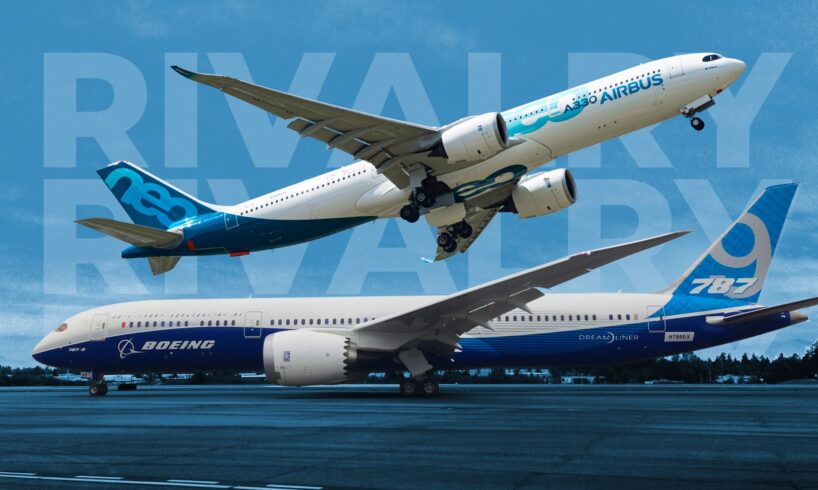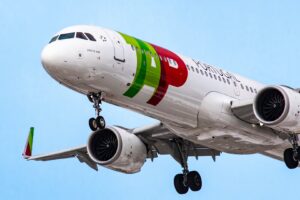
The numbers are in, and Boeing and Airbus met their overall monthly production targets for July 2025. Airbus continued to deliver more aircraft than Boeing, allowing it to continue extending its year-to-date lead in deliveries. At the same time, Boeing’s deliveries have recovered from the slump seen in 2024, but still have a way to go to fully recover to their pre-2019 numbers.
July was a slow month for new buys, with Airbus receiving as many cancellations as orders. 2025 has seen a rebalancing of Airbus narrowbody orders, with a net decrease in A320neo orders as more airlines select the larger and longer-range A321neo instead. The A320neo has received 80 new orders and 84 cancellations in 2025, while the A321neo has clocked 214 new orders with no cancellations.
By The Numbers: Boeing & Airbus Orders In July 2025
Photo: First Class Photography | Shutterstock
After strong orders for Boeing and Airbus in June, purchases for both planemakers in July were lacking. In July, Boeing achieved 30 orders for its Boeing 737 MAX aircraft and a single order for its Boeing 787 for a total of 31 orders. Overall, for the first half of 2025, Boeing has accumulated more orders than Airbus, having secured 699 gross orders to Airbus’s 501. Meanwhile, in July, Airbus got three orders for the A320neo family and four orders for its Airbus A330neo.
At the same time, Air Lease Corporation cancelled an order for seven A350 Freighters due to delays, tariffs, and uncertainty about the air cargo market. While the A320 family has a larger backlog than the 737 MAX, the MAX has outsold the A320neo in the first six months of 2025. Boeing has also logged 243 gross orders for the 787, with many of these coming from the Middle East, particularly Qatar Airways.
In June, meanwhile, Airbus secured 40 orders for the A220, 57 orders for the A320neo family, 61 orders for the A330neo, and 45 orders for the A350, giving it a total of 203 orders. Also in June, Boeing managed to secure 54 new orders for the Boeing 737 MAX and 62 new orders for its Dreamliner for a total of 116 gross new orders. Orders for aircraft tend to be rather lumpy, so it’s typically better to look at trends over a year or two, rather than short periods of a month or two.
What About Boeing & Airbus Deliveries In July?
Photo: Markus Mainka | Shutterstock
When it comes to deliveries, Airbus has maintained its position as the world’s largest aircraft manufacturer, outdelivering Boeing in the first half of 2025. Boeing has delivered 280 commercial aircraft in the first half of 2025, up from 175 in 2024: 209 737 MAX aircraft, 14 767s, 20 777s, and 38 787s. Passenger production of the 767 and the 777 (besides the uncertified 777X) has ended, so any 767 or 777 aircraft being delivered are freighters or military air tanker variants.
In the first half of 2025, Airbus delivered 46 A220s, 286 A320neo family aircraft, 14 A330s, and 27 A350s for a total of 373, meaning that Airbus outpaced Boeing’s deliveries by almost 100 aircraft. As a side point, Airbus’ A320 family is poised to overtake the Boeing 737 as the most delivered commercial aircraft in history by cumulative deliveries.
Airbus aircraft types
July deliveries (per Airbus)
Year to date
Boeing aircraft types
July deliveries (per Boeing)
Year to date
Airbus A200
5
46
Boeing 737 MAX
37
209
Airbus A320
54
286
Boeing 767
1
14
Airbus A330
2
14
Boeing 777
2
20
Airbus A350
6
27
Boeing 787
8
38
Total
67
373
Total
48
280
In July, Airbus delivered five A220s, 54 A320neo family jets, two A330s, and six A350s for a total of 67 aircraft. Meanwhile, Boeing delivered 37 Boeing 737s, a single 767, two Triple-Sevens, and eight Dreamliners, totaling 48 aircraft. This means that, even with its higher gross orders, Boeing’s backlog fell in July.
Current Production Targets By Aircraft
Photo: Peter Krocka | Shutterstock
According to Flight Plan, the current Airbus’ monthly production target is 67 aircraft, meaning the airplane maker exactly met its target overall. The target was broken down into seven A220s, 50 A320neos, four A330s, and six A350s. Meanwhile, Boeing’s July deliveries were one under its current target of 49 monthly units. Its targets include 38 Boeing 737 MAX, three 767s, three 777s, and five Dreamliners. Both Airbus and Boeing are trying to ramp up production to serve their growing backlogs.
In recent years, both planemakers have struggled to deliver aircraft in high enough numbers, leading to delays and airlines holding onto their aging aircraft for longer. This has caused the average age of aircraft flying today to increase and has forced airlines like Korean Air to keep its Boeing 747s, older 777s, and A380s in service for longer. Boeing, in particular, is still struggling not only from supply chain issues caused by the pandemic, but also by the fallout from the MAX crashes of 2018 and 2019.
Boeing has still not had a “normal” year of aircraft deliveries since 2018, and the crashes attributed to hiding the full implications of the Maneuvering Characteristics Augmentation System (MCAS) from the FAA caused a collapse in trust. This has contributed to the FAA still withholding type certificates for the MAX 7, MAX 10, and 777X. The latter’s novel folding wingtips may also be a factor in holding up certification, requiring more intensive testing.
A Look At Boeing’s Backlog At The End Of July
Photo: Falcons Spotters | Shutterstock
At the end of July, Boeing had a total backlog of 6,563 jets: 4,862 737 family aircraft, 94 767s, 614 777/777X airliners, and 993 787s. The 737 orders include six remaining orders for the 737-800A, 316 orders for the still uncertified MAX 7, 3,080 orders for the MAX 8, 187 orders for the MAX 9, and 1,273 orders for the upcoming stretched MAX 10. The 737-800A orders are for the P-8 Poseidon maritime patrol aircraft based on the 737NG, which are still on order from the US, Germany, and Australia.
The Boeing 767’s production is winding down, and production of the freighter variant is expected to come to an end in 2027 as new regulations come into force. Of the 94 aircraft remaining on order, 67 are KC-46A Pegasus tankers with 61 ordered by the US Air Force, four by Israel, and two by Japan. The remaining 27 orders are for 767-300F freighters, most of which have been ordered by FedEx and UPS.
Boeing aircraft
Backlog at the end of July
737
4,862
767
94
777/777X
614
787
993
Total
6,563
The Boeing 777s on order include 63 older 777F freighters and 551 upcoming 777X jets (including 777-8s, 777-9s, and 777-8Fs). The first 777-9s are expected to be delivered in 2026 to Lufthansa. Boeing’s books also show five passenger Boeing 777-300ERs on order for Pakistan International Airlines. However, these have sat there for years, and Boeing seemingly delivered its final passenger 777-300ER in 2024. As such, it is doubtful that these orders will ever be fulfilled.
Analyzing Airbus’ Backlog At The End Of July
Photo: Ian Dewar Photography | Shutterstock
Airbus has a substantially larger backlog than Boeing, thanks to stronger demand for its A320neo family of narrowbody aircraft. Its total backlog stands at 7,634 aircraft, some 2,772 more than Boeing. This includes 506 A220s, 7,128 A320neos, 285 A330neos, and 759 A350s. The A220 is formerly the Bombardier CSeries and is mostly produced in Quebec, with its backlog including 46 A220-100s and 460 A220-300s.
The A320neo family orderbook includes 25 examples of the unpopular A319neo, 1,823 orders for the standard A320neo, and 5,280 orders for the A321neo. The A321neo series itself includes the standard A321neo, the longer-range A321LR, and the extra-long-range A321XLR versions. The A321XLR comes with a range of 4,700 nautical miles, allowing it to fill the void left by the termination of the mid-sized Boeing 757.
Airbus aircraft
Backlog at the end of July
Airbus A220
506
Airbus A320neo
7,128
Airbus A330
285
Airbus A350
759
Total
7,634
With the Airbus A330neo, almost all orders (280) are for the favored A330-900 variant, and only five orders remain for the less popular A330-800 variant. The A350 has three variants: the A350-900 has 438 outstanding orders, the stretched A350-1000 has 256 orders, and the freighter variant has 65 orders. Airbus may be ahead on total orders, but Boeing is ahead on widebody orders.
Airbus Retains Its Place As The Biggest Aircraft Maker
Photo: christopheronglv | Shutterstock
Airbus continues to retain its position as the world’s largest planemaker, followed by Boeing. These two companies continue to be the only airplane manufacturers in the world making widebody aircraft, although China’s COMAC is also developing a twin-aisle jet. The only other manufacturer making jet-powered commercial planes powered commercial jets is Embraer, as Bombardier exited the market after selling the CSeries to Airbus.
Looking forward, however, this may start to change. COMAC has ambitious plans to directly change Airbus and Boeing’s lineups, while Russian companies are still trying to substitute Western-sourced parts and put the Sukhoi Superjet and Yakovlev MC-21 back into production. Since exhausting stockpiled components, Russia has not delivered a single commercial jet since the sanctions were imposed in 2022.
JetZero, with its mid-sized blended-wing-body aircraft, and Boom Supersonic, with its supersonic Overture aircraft, are also looking to enter the market before 2030. However, for now, Airbus remains ahead in total orders and retains the greatest ability to deliver aircraft. Boeing is looking to exceed its low 2024 delivery total (348 aircraft), while more time is needed to see if Airbus will end 2025 exceeding the 766 deliveries that is recoreded in 2024.






